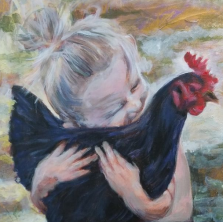Okay, we’re onto Part 2 of our project of counting your chickens before they hatch. As we said earlier, we’re a bit in the middle of this and if we have any other conclusions we will supplement this information.
We, at the Firefly, are doing a few sustainable living projects just because it is important that someone remember how. Are we chicken experts? Certainly not. All we have is experience, and are committed to maintaining a learning organization.
Back Story
We explored some of the important economic issues on this topic in our previous post, which we hope you will click and share:
Incubation History
According to the reference below, chickens hatched eggs by themselves perfectly fine for a long time. A method was invented in China using heated rice which took advantage of the heat generation of the little warm blooded chicks themselves. This allowed captive incubation.
The first commercially available incubators were introduced in the US in the 1870’s, using oil as a heat source. There is a reference below from the NIMH that states that chicks that were hatched in an incubator have higher levels of stress hormone cortisol, versus their more naturally raised brothers and sisters.
We try to make up for that by sending loving vibrations through the air.
The numbers thrown around as to how successful incubation is in the real world are as follows
| Method | Description | Hatch Rate |
| “Natural” | Chickens sitting on eggs and hatching | 80% |
| “Parched Rice” | Asian method using body heat | 80% |
| Incubated | Electric, Kerosene or oil heated incubators | 75-80% |
Effects of Rural Electrification
We have no better source than the screenplay of Noel Langley, Florence Ryerson and Edgar Allen Woolf as evidence of the effects of rural electrification on the poultry industry. This government intervention is one of the key influences of the poultry industry developing into what it is, namely the huge, production driven industry that we now know and love.

This famous film was released at the same time as the Firefly, for historical reference.
Order of Operations: Hatch chickens first, then count.
Here is a summary table:
| Time Frame | Event | Reason |
| Several days before incubation | Gathering Eggs | Get together a batch of eggs which will hatch together. |
| 0 Day | Begin Incubation | Fertilized fetal chicks will start to develop from fertilized eggs |
| Days 2-18 | Turning eggs gently 3X/day | Mimics the turning over the eggs by the chicken. Do not turn after day 18. |
| Day 5 onward | Candle eggs “every few days” | Confirm that embryo chickens are developing |
| Day 18 | Increase humidity to 65-70% | Make sure chicks don’t get stuck inside shell |
| Day 21 | Hatching Begins | Observe and bask in bringing life to the world. Do not disturb hatchlings. |
| Day 24 | (72 hours after hatching) | Remove surviving hatchlings from incubator, put in brooder pen, start feeding chick starter and giving water. |
| 30 days after hatching | Chickens hopefully surviving and moving normally | Observe normal activity. Make sure they are warm and have water |
| 45 days after hatching | Move to halfway house. | Still too young to be sent out with the flock, vulnerable to being pecked at and also predator/playful dog attack. |
| 90 Days after Hatching | OK to count your chickens | The world is full of hazards for a chicken, and even if you survive, you’re still a chicken. |
The Incubator
Here it is. This thing will maintain a known temperature, also allows you to monitor humidity, and add water to the incubator to ensure that the conditions simulate a brooding chicken’s warm behind.
Water is added manually through a small port. There is an automatic egg turning rack built in that allows the eggs to be gently turned over without getting your fingerprints all over them.
The preferred temperature for hatching, per Virginia Tech, is 99 degrees F, but the temperature should not be allowed to get more than 103F for more than a few hours, otherwise the embryos will be damaged, and not hatch. Same goes for under 96F, which sort of explains why the day we had a power failure was not great for our hatch rate.
For the first 18 days, the humidity should be 60 percent, thereafter it should be between 65 and 70 percent to maintain niceness. Too much humidity can cause hatching problems, and too little may cause the chicks to stick to the inside of the shell when they try to hatch.
Hatching Day
The early bird may or may not get the worm, but in our opinion, the first couple of days out of the egg, the early arrivers do have a competitive advantage in feeding and pecking.
Hatching should be allowed to continue without opening the incubator, and the resulting chicks removed from the incubator together after 72 hours after the first hatching.
What to do with the eggs that didn’t hatch? That is a bit of an ethical dilemma since they represent life. We are open to suggestion. All we can think of is that we don’t want to feed them to the dogs, also would hate to dispose of them unkindly just in case there were stragglers.
Feel free to recommend.
Counting your Chickens Before They Hatch Part 2
To be perfectly honest, we’ve yet to achieve the commercially reasonable hatch rate of 80%. However, our hatching operation has been successful in producing a few healthy chickens to keep the flock strong.
Go us, for bringing life to the world. We’ll write the book later.
Links and References
Invention of the Incubator
NIH ill effects of artificial hatching
https://www.ncbi.nlm.nih.gov/pmc/articles/PMC6382823/
Egg Breakout Rate should be greater than 80%
https://www.thepoultrysite.com/articles/breakout-analyses-guide-for-hatcheries-1
Comparison of various methods
Wizard of Oz
http://www.sellingyourscreenplay.com/wp-content/uploads/screenplay/scripts/The-Wizard-of-Oz.pdf
Rural Electrification
Virginia Tech
Why you should candle your eggs
https://www.brinsea.com/brochures/EggCandling.pdf
When to introduce chicks to the flock
![]()
